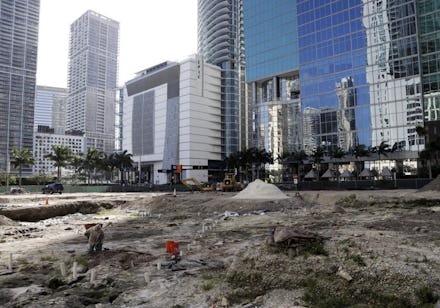A Prehistoric Village Was Just Found in Downtown Miami

1. What did they find?
One of the most significant Native American villages ever found, dating back around 2,000 years. The village belonged to the Tequesta, a tribe that lived in the South West Florida area since 3rd Century B.C.
2. Where did they find it?
Underneath one of the last remaining vacant lots in the middle of downtown Miami. The area is currently undergoing development for a $600 million complex of four sky skyscrapers and an upscale entertainment center called Metropolitan Miami. Random fact: Former NBA star Shaquille O’Neal is one of the partners on the project.
3. How did they find it?
By law, any developer must arrange for an archaeological survey before being cleared to build. When Archaeologist Bob Carr initially examined the site a decade ago, he found the first evidence in the form of a circle in the bedrock. He and his team had planned to lift out the circle before construction. However due to the real estate bust, both these plans and the development of the site were put on hold. When plans moved forward again and Carr’s team was allowed back on site last year, they found even more circles, an entire village’s worth.
4. How did the village get buried?
In 1897, the Royal Palm, one of Miami’s first hotels, was built right over the Tequesta site to encourage new visitors to the region. During construction, builders found a mound where 50 skulls were buried.
5. What happened to the Tequesta?
After living peacefully in the area for over 2000 years, they first came into contact with Europeans exploring the area in the 1500s. By the late 1700s, they had disappeared entirely, victims of war, European disease and the turmoil of being resettled by the Spanish in Cuba.
6. What exactly have they found at the site?
The eight uniformly carved holes in native limestone found by the archeologists are believed to be foundation holes for Tequesta Indian dwellings. Carbon testing dates the site to 600 A.D. In addition, they discovered hundreds of postholes arranged in linear, parallel segments which are proposed to be foundations for boardwalks connecting the dwellings. Various artefacts including axes and conche shell tools were dug up.
The excavation also uncovered the foundations to the Royal Palm hotel, which had been destroyed in 1930 after a hurricane.
7. Why is this site important?
“What’s unusual and unique about the site is that it’s this huge chunk of land where a major part of this ancient Tequesta village site is preserved,’’ Carr said in an interview. “It’s one of the earliest urban plans in eastern North America. You can actually see this extraordinary configuration of these buildings and structures.’’
8. So uh, is Shaq now gonna show up and help with the dig?
That would be amazing! Dr. O’Neal does in fact have a PhD, but it’s in 'Organizational Learning and Leadership' rather than archaeology, so we’ll have to wait and see. Probably not.
9. What’s going to happen to the site now?
Officials are now considering the site for National Historic Landmark status, with preservationists also calling for designation as a UNESCO World Heritage site. However, with leases signed and timetables for opening up the entertainment complex in place, the developer, MDM, intends to press on. MDM has offered to integrate part of the village remnants by cutting out a section of limestone and displaying the Tequesta structure in a public plaza.
But this is likely to be unacceptable to preservationists, city board members, and a wide international community who see great archealogical value in the site. Now begins the battle to save an important part of the city’s history.